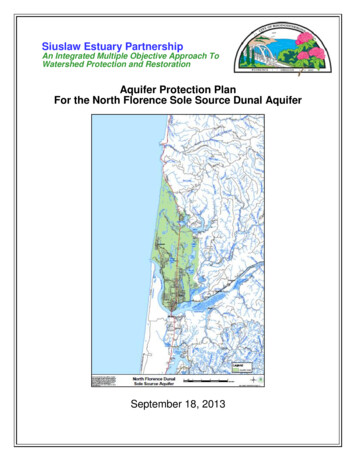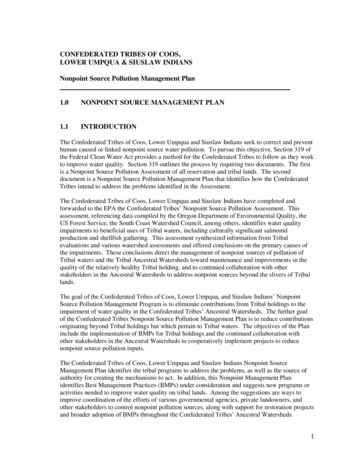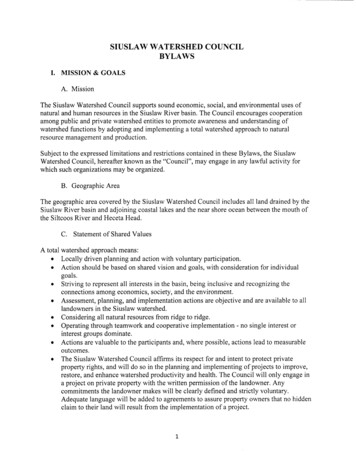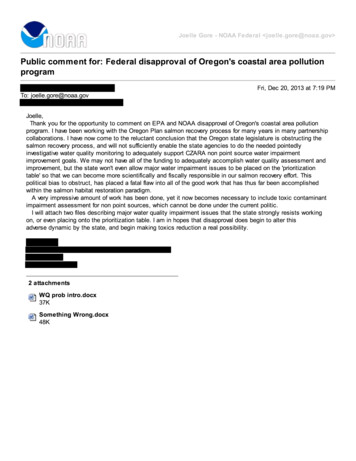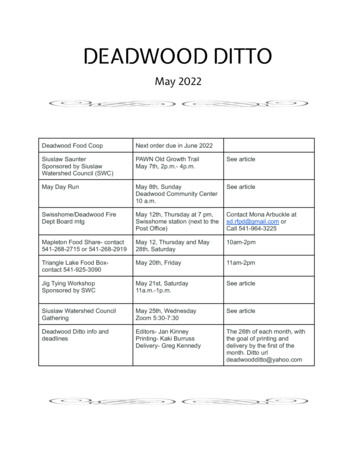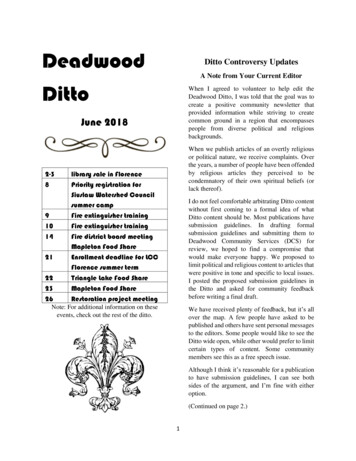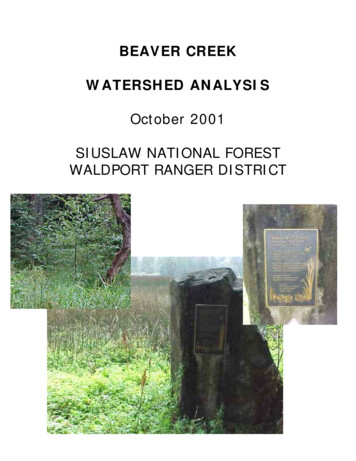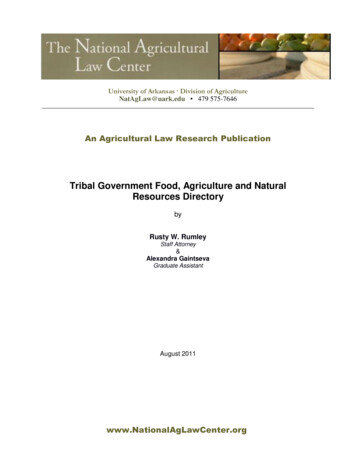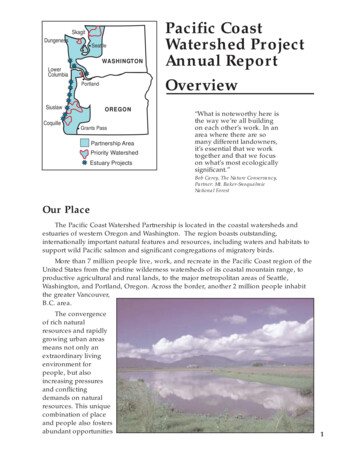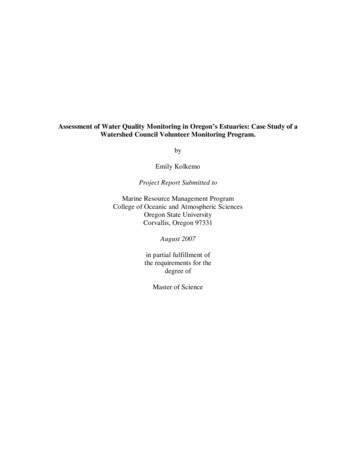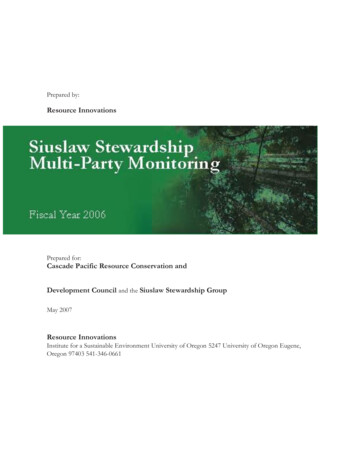
Transcription
Prepared by:Resource InnovationsPrepared for:Cascade Pacific Resource Conservation andDevelopment Council and the Siuslaw Stewardship GroupMay 2007Resource InnovationsInstitute for a Sustainable Environment University of Oregon 5247 University of Oregon Eugene,Oregon 97403 541-346-0661
Siuslaw Stewardship Multi-Party Monitoring Fiscal Year2006Prepared by:Resource InnovationsFor:Cascade Pacific Resource Conservation and Development Counciland theSiuslaw Stewardship GroupMay 2007Resource InnovationsInstitute for a Sustainable Environment University of Oregon 5247 University ofOregon Eugene, Oregon 97403 541-346-0661
Executive SummaryThe Siuslaw Stewardship Project is a model community-driven forest restoration collaborative. It isan innovative partnership between the Siuslaw National Forest and a diverse group of localresidents and organizations known as the Siuslaw Stewardship Group. The Siuslaw StewardshipProject aims to restore watershed health and contribute to the economy of the Siuslaw basin andcoastal lakes area by creatively applying the stewardship contracting tools.This report documents the biophysical accomplishments and economic impacts of Forest Servicestewardship contracts, retained receipt projects, and Wyden Amendment projects that were activewithin the Siuslaw stewardship area in fiscal year (FY) 2006. The report establishes a baseline forfuture monitoring efforts. It also serves as a tool to help refine and adapt future stewardshipcontracting efforts in the Siuslaw stewardship area.MethodsInformation on project accomplishments for all three types of projects was collected from electronicrecords and short telephone interviews with staff from the Siuslaw National Forest and projectmanagers of sponsoring agencies. Photopoints were taken at two of the stewardship contracts toestablish a long-term record to track changes over time resulting from management activities.Stewardship Group participants and other interested parties also reviewed project accomplishmentson field trips at a variety of locations and project types.Information on the value of material removed from stewardship contracts, the destination and use ofthat material, and its contribution to the local economy was gathered from the two timber companiesthat purchased the stewardship contracts. Additional data regarding the economic impacts of theseprojects, the retained receipt and Wyden Amendment projects were collected via telephoneinterviews with contractors and subcontractors.Summary of Biophysical Accomplishments in FY 2006The various stewardship contracting activities on the Siuslaw National Forest and in the Siuslawbasin resulted in a significant biophysical accomplishments in FY 2006 including:Forest Service Stewardship Contracts: Thinning treatments on 326 acres late successional reserve (LSR)Creation of 35 mature tree snagsNoxious weed control over 41 acresBrushing and maintenance work along 4 miles of trailClosure, storm-proofing, or increased emergency access along 25.2 miles of road
Forest Service Retained Receipt Projects Planting and release of trees and native grasses on 33 acresNoxious weed control over approximately 100 acresPlacement of large woody debris along one mile of streamReconstruction or decommissioning of approximately nine miles of roadsWyden Amendment Projects Planting and release of 17,000 conifers; 5,500 deciduous trees; and 10,000 other nativeplants on private lands Placement of large woody debris along more than 3 miles of stream Construction of more than 3,000 feet of fence to exclude cattle from riparian areasSummary of Economic ImpactsThe thinning treatments completed in FY 2006 resulted in: Approximately 5,300 thousand-board feet (mbf) of timber for the two companies thatpurchased stewardship contracts, Georgia Pacific and Swanson Superior. This volume accounted for approximately 2.7% of the total volume processed at thecompanies’ mills during the fiscal year. The thinning treatments resulted in over 500,000 in receipts that were reinvested in highpriority restoration projects on public and private lands. The total value of all contracts and sub-contracts for stewardship contracts, Forest Serviceretained receipt projects, and Wyden Amendment projects was approximately 3.9 million.This includes the value of sub-contracts on stewardship contracting projects dating back to theinception of the program in FY 2004 ( 3.3 million), and all Siuslaw Stewardship Funds paid inFY 2006. Because sub-contracts for stewardship contracts span multiple years, it is difficult tospecify the economic impacts solely in FY 2006. The Siuslaw National Forest and Cascade Pacific Resource Conservation and DevelopmentCouncil awarded 3.9 million in contracts to 30 different contractors. Local (Siuslaw basin) contractors captured approximately 35% of the overall total contractvalue, or approximately 1.4 million. Contractors located elsewhere in Lane County were awarded about 50% of the total contractvalue, or approximately 1.95 million. Stewardship contracts, retained receipt projects, and Wyden Amendment projects creatednearly 60,000 hours of work from FY 2004 through FY 2006, or the equivalent of approximately 28full-time positions for one year.
Table of ContentsList of Tables. iv List ofFigures . v Section One:Introduction. 1About Stewardship Contracting.1 StewardshipContracting in the Siuslaw Basin .2 About the SiuslawStewardship Group.2SectionTwo: Methods. 4Definitions .4 mentationMonitoring.6 Challenges and Limitations.6Section Three: Biophysical Accomplishments . 7 ForestService Stewardship Contracts.7 Forest ServiceRetained Receipt Projects. 14 Wyden AmendmentProjects . 17Section Four: Economic Impacts . 20 ForestService Stewardship Contracts. 20 Forest ServiceRetained Receipt Projects. 21 Wyden AmendmentProjects.22SummaryofKeyFindings. 22SectionFive:PhotopointMonitoring.23Section Six: Lessons Learned From Field Trips . 25Field Trip #1 . 25 Field Trip#2 . ppendix A: Photopoint Examples. 2928
List of TablesTable 1. Total Accomplishments on Divide Thin Pilot, Misery Thin Pilot, Chopper Thin, andWalker Thin Stewardship Contracts—Siuslaw National Forest, as of09/30/2006.8Table 2. Volume Removed and Value of Materials—Siuslaw National Forest StewardshipContracts, as of 09/30/2006.9 Table 3. TotalReceipts Retained—Siuslaw National Forest Stewardship Contracts, as of09/30/2006.9Table 4. Work Accomplished, Total Volume, and Value of Material—Divide ThinPilot, Siuslaw National Forest, FY 2006.10 Table 5. Work Accomplished, Total Volume, and Value of Material—MiseryThin Pilot, Siuslaw National Forest, FY2006. 11 Table 6. Work Accomplished,Total Volume, and Value of Material—Chopper Thin, Siuslaw National Forest, FY2006. 12 Table 7. Work Accomplished,Total Volume, and Value of Material—Walker Thin, Siuslaw National Forest, FY2006. 13 Table 8. Retained ReceiptProjects Expenditures and Accomplishments—SiuslawNational Forest, FY 2006. 15 Table 9.Wyden Amendment ProjectExpendituresand Accomplishments, FY 2006 . 18 Table 10. MaterialProduced and Estimated Impact on Mill Employment—SiuslawNational Forest Stewardship Contracts, FY 2006 . 20Table 11. Photopoints Locations and Notes—Walker and Misery Thin StewardshipContracts, Siuslaw National Forest . 24
List of FiguresFigure 1. Misery ThinSale Area Map Legend . 29 Figure 2.Misery Thin Photopoint Locations in Units 16, 17, 18, 8A, and 8B . 30 Figure 3. MiseryThin Photopoint Topographic Map . 31
Section One: IntroductionThis report summarizes the accomplishments of the Siuslaw Stewardship Project on the SiuslawNational Forest during fiscal year (FY) 2006. Cascade Pacific Resource Conservation andDevelopment Council contracted with Resource Innovations to compile this report, using funds thatthe Siuslaw National Forest retained through stewardship contracts. The report details informationthe biophysical accomplishments and economic impacts of the activities associated with stewardshipcontracting. It also summarizes the Siuslaw Stewardship Group monitoring field trips and describesthe methods used in the photopoint series that is documenting the long-term effects of stewardshipcontracts in the Siuslaw basin.The report answers questions about the nature and quantities of the restoration treatments that werecompleted, as well as other information about the by-products of restoration treatments. The reportdoes not evaluate whether the amount of work completed was sufficient or whether the projectscompleted were most appropriate.In describing the economic impacts of projects, the report identifies the number of people whoworked on the projects, the percentage of those contracts which were completed by Siuslaw basinand other Lane County contractors, and the types of wages and benefits associated with those jobs.This is the first year of what is designed to be a multi-year effort. As such, these numbers representa starting point (although not one taken at the beginning of the project) and an attempt to create aneffective data gathering, reporting, and monitoring system.About Stewardship ContractingStewardship contracting is an innovative approach to managing forests and watersheds that isrooted in collaboration and adaptive management. Stewardship contracting is a suite of authoritiesor contracting tools that are intended to help the agencies meet land management objectives andrural community needs. It is the blending of land management and rural community developmentthat makes stewardship contracting unique. The guiding regulations from the Forest Serviceencourage strong collaboration between the federal agencies and local and regional partners andinterests.In 2003, Congress enacted legislation enabling the US Forest Service and the Bureau of Land1Management (BLM) to use stewardship contracting to accomplish land management . Specificmechanisms authorized by the legislation include: Exchange of goods for services: Contractors can be paid in goods—with the value of anytimber or other forest products removed by the contractor used to offset what the agency owes thecontractor for services performed. Receipt retention: Excess receipts from the sale of timber or other forest products removed
can be kept and used by the agency, rather than being deposited in the U.S. Treasury. Best-value contracting: Contracts must be awarded on the basis of achieving best value tothe government. A variety of criteria, in addition to price, can be used in making the awarddetermination. End-results contracting: The agency determines the end result desired for the work, but thecontractor has flexibility to propose the methods to be used, including, in some instances, whichindividual trees to cut. Multi-year contracts: Service contracts can be let for up to 10 years, instead of the current 52year maximum .116 U.S.C. 2104 Note (Revised February 28, 2003 to reflect Sec. 323 of H.J. Res. 2 as enrolled)
Stewardship Contracting in the Siuslaw BasinThe Siuslaw River basin is located on the central Oregon coast. Steep ridges and rugged mountainsdominate the upper part of the watershed whereas dunes, broader floodplains, and wetlands are atthe bottom of the watershed. Federal agencies manage over half of the land within the watershed.Siuslaw National Forest manages much of the land in the western part of the watershed and theBLM manages the lands in the eastern half of the basin. Much of the lowlands, estuaries, and rivervalleys are privately owned.The Northwest Forest Plan designated much of the forested land of the Siuslaw National Forest aslate successional reserve (LSR). Late Successional Reserves are managed to provide habitat forthreatened and endangered species. The Siuslaw National Forest uses stewardship contracting as ameans to address the health of the entire basin. Salmon habitat restoration and enhancement is highpriority in the basin. Given that much of the lands with the highest habitat potential for salmonidsare on private land, there is a natural strategic partnership between the National Forest and theSiuslaw Watershed Council, Soil and Water Conservation District, Siuslaw Institute and others thatpromote conservation on private lands.About the Siuslaw Stewardship GroupThe Siuslaw Stewardship Group is a collection of local and regional organizations andindividuals that collaborate with the Siuslaw National Forest on the planning, implementation,and monitoring of the stewardship projects within the Siuslaw basin. The Stewardship Groupdedicates much of its attention to managing the Siuslaw Stewardship Fund, a subset of thereceipts retained from stewardship contracts. Group participants include:2Adapted from tewardshi p3.html
Cascade Pacific Resource Conservation & Development Council (Cascade RC&D)EcotrustLane CountyOregon Wild (formerly Oregon Natural Resources Council)Private residents and landownersResource InnovationsSiuslaw National ForestSiuslaw Soil and Water Conservation DistrictSiuslaw Watershed CouncilThe Siuslaw Institute
Section Two: MethodsResource Innovations used a variety of methods to gather data for this report. Where possible,we analyzed activities from fiscal year (FY) 2006—October 1, 2005 to September 30, 2006.DefinitionsThis report uses the following definitions:Stewardship contracts—Contracts performed on the Siuslaw National Forest using an IntegratedResource Contract-Timber or an Integrated Resource Contract-Service.Retained receipts projects—Service contracts performed on the Siuslaw National Forest usingfunds generated from stewardship contracts.Wyden Amendment projects—Contracts on private lands and public lands (other than the SiuslawNational Forest) administered through Cascade Pacific Resource Conservation and DevelopmentCouncil using funds generated from stewardship contracts. The Wyden Amendment authorizes theForest Service to use appropriated funds to complete projects on private land, provided thoseprojects provide a benefit to national forests.Local—Communities within the boundary of the Siuslaw River watershed and the coastal lakesbasins.Semi-local—Communities in Lane County, Oregon but not “local”.Biophysical AccomplishmentsForest Service Stewardship ContractsThe Siuslaw National Forest tracks the progress of the stewardship contracts and associatedprojects on the forest, including the projects within the Siuslaw basin. We acquired information onwork accomplishments and related financial data for each of the four stewardship contracts fromthe Operation Manager for the Central Coast District, formerly the Mapleton Ranger District.Forest Service Retained Receipt ProjectsThe Siuslaw National Forest also tracks the progress of retained receipt projects on the Forest. Weacquired information on work accomplishments and related financial data for each of the eighteenForest Service retained receipt projects from the Operation Manager for the Central Coast District.Wyden Amendment ProjectsCascade Pacific Resource Conservation and Development Council maintains all WydenAmendment project proposal forms, final project reports, and annual monitoring reports submittedby sponsoring agencies. We used these documents to compile project objectives andaccomplishments for each of the 14 Wyden Amendment projects that were active during FY 2006,3including those that were in monitoring status . We contacted project managers of each of the
sponsoring agencies to obtain the status and FY 2006 accomplishments of the individual projects.
Economic ImpactsImpacts to Contracting FirmsWe conducted a series of telephone interviews to determine the economic impacts to contractingfirms working on stewardship contracts, Forest Service retained receipt projects, and WydenAmendment projects. We obtained contact information for ten subcontractors on stewardshipcontracts from the two timber companies that purchased the stewardship contracts. The OperationsManager on the Central Coast District provided contact information for 11 contractors on ForestService retained receipt projects. Lastly, we obtained contact information for 11 contractors onWyden Amendment projects from project managers of sponsoring organizations. In sum, weinterviewed 30 different contractors and subcontractors via telephone. We asked the respondentsfor the following information: Prices paid to subcontractors in FY 2006 (stewardship contracts only)Number of people who worked on each projectTypes of work performedDuration of jobsAverage wages paid to employeesEmployees place of residenceWe used Forest Service records to obtain prices paid to contractors for work on retained receiptprojects, and we used project proposal forms to obtain total stewardship funds awarded to WydenAmendment projects. Total Wyden Amendment project expenditures included prices paid tocontractors, material acquisition, and related project sponsor administration costs.Volume to MillsTo assess the relative impact and value of materials derived from the stewardship contracts, weconducted short telephone interviews with the Operations Managers at the two mills that purchasedthe four contracts. We asked them about the following:3For consistency, we did not include projects that did not have signed contracts by September 302006, even if minimal work had begun during the fiscal yearth
Location where the materials were processedVolume of material processed at those locationsTypes of products created from materialPercent of volume processed annually that these contracts representedNumber of full-time employees at the mill.Implementation MonitoringThe monitoring effort also included additional photopoint monitoring of a sample of the stewardshipcontracts on the Siuslaw National Forest. The purpose of the photopoint monitoring was to developan anecdotal record of change over time resulting from management activities. The photo seriescontinued the previous monitoring efforts begun in 2005 on Chopper Thin by the Siuslaw Institute.Photopoint series were taken on Walker Thin and Misery Thin Pilot stewardship projects.Photopoint locations were selected in thinning units where implementation had not begun. Theprotocol for the photopoint monitoring was as follows: Ten sets of photopoints: o Five sets on the Walker Thin Stewardship Project o Five sets on the Misery Thin Stewardship Project Each set of photopoints included: o Four cardinal-direction photos and one of the canopy at each site o A map with route and latitude and longitude coordinates for each site Ten rebar stakes installed with colored flagging, one at each photo point site.Challenges and LimitationsThis was the first undertaking of this type in the Siuslaw basin and there were some challenges tocollecting data for this report. Project accomplishments for the Wyden Amendment projects,specific to FY 2006 for instance, were not always available. This is because final project reports didnot always specify the accomplishments within FY 2006, but rather over the duration of the project.Much of the FY 2006 information was ultimately collected through conversations with individualproject managers.Information regarding the benefits to contractors from stewardship contracts was also difficult toobtain. Timber companies consider the prices paid to individual subcontractors proprietary andwould not release that information. This made it difficult to gauge the economic impact of thoseprojects. Figures reported by contractors in interviews are inclusive of the overall contract price,which may span the duration of the project (from FY 2004 through FY 2006).
Section Three: Biophysical AccomplishmentsThis section describes the accomplishments of FY 2006 stewardship contracts, retained receiptprojects, and Wyden Amendment projects on private land.Forest Service Stewardship ContractsAs of September 30, 2006, the Forest Service had begun implementing four stewardship contracts inthe Siuslaw basin—Divide Thin Pilot, Misery Thin Pilot, Chopper Thin, and Walker Thin.Summary of All ProjectsContractors performed thinning treatments on 326 acres in fiscal year 2006 and completed a host ofother service projects (Table 1). Two projects, Divide Thin Pilot and Chopper Thin, accounted forall the treated acres.
Table 1. Total Accomplishments on Divide Thin Pilot, Misery Thin Pilot, Chopper Thin, and WalkerThin Stewardship Contracts—Siuslaw National Forest, as of 09/30/2006
Planned AccomplishmentPlannedQuantityUnit ofMeasureCompletedPrior to FY 06CompletedDuring FY 06TotalCompletedto Date(09/30/06)Thinning TreatmentsLSR Thinning TreatmentsLate Non-Commercial Thinning -RiparianLate Non-Commercial Thinning 6978280In-Stream Structure CreationCoarse Woody Debris CreationStream Structure Placement -Helicopter3,685240EachEach0000003,685240Snag and Downed Wood CreationSnag Creation -Mature TreeSnag Creation -Young Tree1252,384EachEach00350350902,384Riparian ReleaseRiparian Release (including conifers)71Acres00071Site Preparation and PlantingSite Preparation and Planting -RiparianSite Preparation and Planting -Upland12219AcresAcres00000012219Early Seral Meadow CreationEarly Seral Meadow Creation47.5Acres00047.5Noxious Weed ControlNoxious Weed Control122Acres0414181Trail Brushing and MaintenanceTrail Brushing and Maintenance5Miles0441RoadworkStorm Proofing and Road ClosureFire Equipment Access60.240024.2124.2136.03Sidecast Pullback3,0050003,005Culvert and Fill r/Misc.Sweet Creek Stump Removal1Each010StewardshipProjectDivide Thin PilotPurchaserSwanson GroupMisery Thin PilotSwanson GroupChopper ThinWalker ThinTOTALGeorgia PacificSwanson GroupStewardshipProject(A) RetainedReceiptsDivide Thin PilotMisery Thin PilotChopper ThinWalker Thin 273,908 0 106,647 0Planned AccomplishmentLSR Thinning TreatmentsCourse Woody Debris CreationMature Snag CreationYoung Snag CreationSidecast PullbackRoad Culvert and Fill RemovalStorm-ProofingRoad DecommissioningNoxious Weed ControlEarly Seral Meadow d Rate 27.75/ton 53.00/ccf(escalated) 30.34/ton 31.39/ton1VolumeRemoved FY0610,958 tonsValue of VolumeFY06 304,0840 ccf 027,878 tons234 tons38,070 tons(C) Stewardship(B) SuspenseCredit CoverageAccountRequired 10,274 0 0 0 490,891 380,000 725 305,000BALANCE (as of 09/30/06) 501,720CompletedUnit ofPrior to FYMeasure06Source: Siuslaw National ForestAcres137Each0Each0Each0Cubic yards0Cubic yards0Miles0Miles0Acres0Acres0QuantityRemaining 845,818 7,345 1,157,247(D) AvailableReceiptsA B-C D 284,182 0 217,538 0CompletedDuring FY061110000000300TotalCompleted 75122020080.5010
Planned AccomplishmentPlannedQuantityUnit ofMeasureCompletedPrior to FY 06CompletedDuring FY 06TotalCompletedto Date(09/30/06)Thinning TreatmentsLSR Thinning TreatmentsLate Non-Commercial Thinning -RiparianLate Non-Commercial Thinning 6978280In-Stream Structure CreationCoarse Woody Debris CreationStream Structure Placement -Helicopter3,685240EachEach0000003,685240Snag and Downed Wood CreationSnag Creation -Mature TreeSnag Creation -Young ngRiparian ReleaseRiparian71Acres from0 each project,0 as well as the0 value of 71Table2 Releaseshows (includingthe totalconifers)volume of es to the Forest Service .Site Preparation and Planting -RiparianSite Preparation and Planting -UplandEarly Seral Meadow CreationEarly Seral Meadow CreationNoxious Weed ControlPlanned AccomplishmentNoxious Weed ControlThinning TreatmentsTrail Brushing and MaintenanceLSR Thinning TreatmentsTrail Brushing and MaintenanceLate Non-Commercial Thinning -RiparianRoadworkLate Non-Commercial Thinning -UplandStormProofingand RoadClosureIn-StreamStructureCreationFire Equipment AccessCoarse Woody Debris CreationStream Structure Placement -HelicopterSidecast PullbackSnag and Downed Wood CreationCulvertSnag Creationand Fill Removal-Mature TreeSnag Creation -Young TreeOther/Misc.RiparianReleaseSweetCreekStump RemovalRiparian Release (including antity122AcresUnit 1900CompletedCompletedPrior to FY 06 During FY 06041Total0Completedto 2,384171EachAcres00 Volume1010Value 0of Volume 71Table2. Volume Removedand Value of Materials—SiuslawNational ForestContracts,ProjectPurchaserBid RateRemovedFY06 StewardshipFY06Site Preparation and Plantingasof09/30/2006Site Preparationand Planting-RiparianAcres0 10,958 tons 0012DivideThin PilotSwansonGroup 12 27.75/ton 304,084Site Preparation and Planting -Upland219 53.00/ccfAcres000219Misery Thin PilotSwanson Group0 ccf 0Early Seral Meadow Creation(escalated)Early SeralMeadow Creation47.5Acres0 27,878 tons 0047.5ChopperThinGeorgiaPacific 30.34/ton 845,818Source: Siuslaw National ForestWalkerNoxiousThinWeed ControlSwanson Group 31.39/ton234 tons 7,345Noxious Weed Control122Acres0 38,070 tons 414181TOTAL 1,157,247Trail BrushingMaintenanceTable3. TotalandReceiptsRetained—Siuslaw National Forest (C)StewardshipContracts,as of 09/30/2006Stewardship(D) AvailableStewardship(A) RetainedTrail Brushing and Maintenance5 (B) SuspenseMiles0 Credit Coverage441ReceiptsProjectReceiptsAccountRequiredA B-C DRoadworkStorm Proofingand Road Closure60.20 024.224.236.0DivideThin Pilot273,908 10,274Miles 284,182Source:Siuslaw NationalFire EquipmentAccess Forest4 0Miles0 0113MiseryThin Pilot0 0CubicChopperThin 106,647 490,891 217,538Sidecast Pullback3,005yards0 380,000003,005Afterfundsserviceprojects andrelated trust fund 0accounts,WalkerThinwere deducted 0 for associated 725 305,000CubicCulvert and FillRemoval produced over 500,000825yards0in fiscal 501,7200 These funds825stewardshipcontractsinreceiptsyear02006 (Table 3).BALANCE(as of 09/30/06)Other/Misc.CompletedTotal goals inwerereinvested in other service projects on public and privatelands thatCompletedmet the restorationSweet Creek Stump5 RemovalEach0 Prior to FY1 During FY1 Completed by0Planned1UnitoftheSiuslawbasin 6StewardshipLSRThinning TreatmentsPurchaser475ProjectCourseDebris Creation573DivideWoodyThin PilotSwanson GroupMature Snag Creation30MiseryThinCreationPilotSwanson GroupYoungSnag751Sidecast Pullback220Chopper ThinGeorgia PacificRoad Culvert and Fill Removal200Walker ThinSwanson GroupBid AcresRateEach 27.75/tonEach 53.00/ccfEach(escalated)Cubic yards 30.34/tonCubic yards 31.39/tonVolume137111Removed FY060 10,958 tons 0000 0 ccf00027,878 tons00234 tonsValue of VolumeFY06 2480 304,084000 845,8180 0 7,345QuantityRemaining22757330751220200 pa
Siuslaw Watershed Council, Soil and Water Conservation District, Siuslaw Institute and others that promote conservation on private lands. About the Siuslaw Stewardship Group The Siuslaw Stewardship Group is a collection of local and regional organizations and
